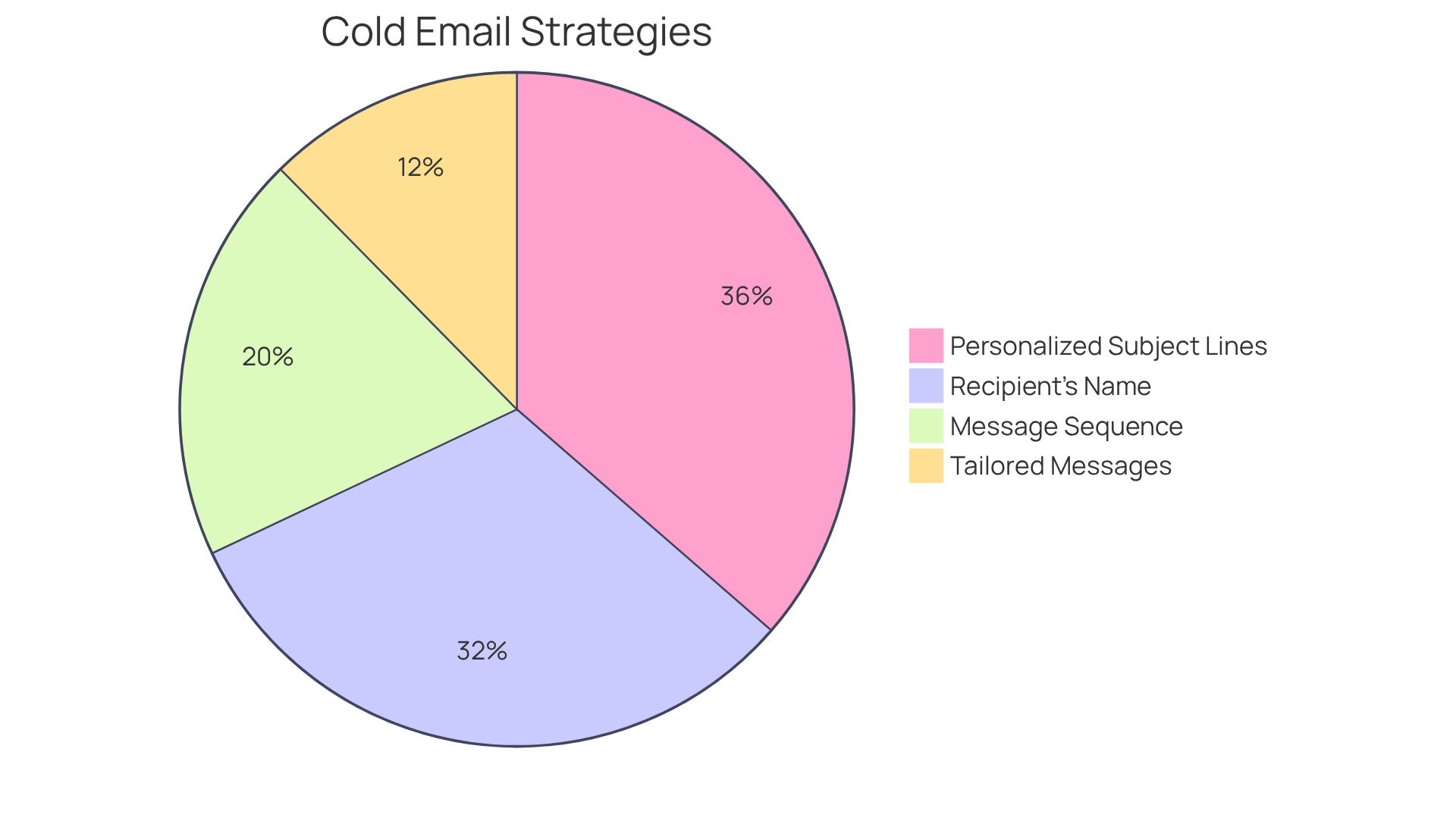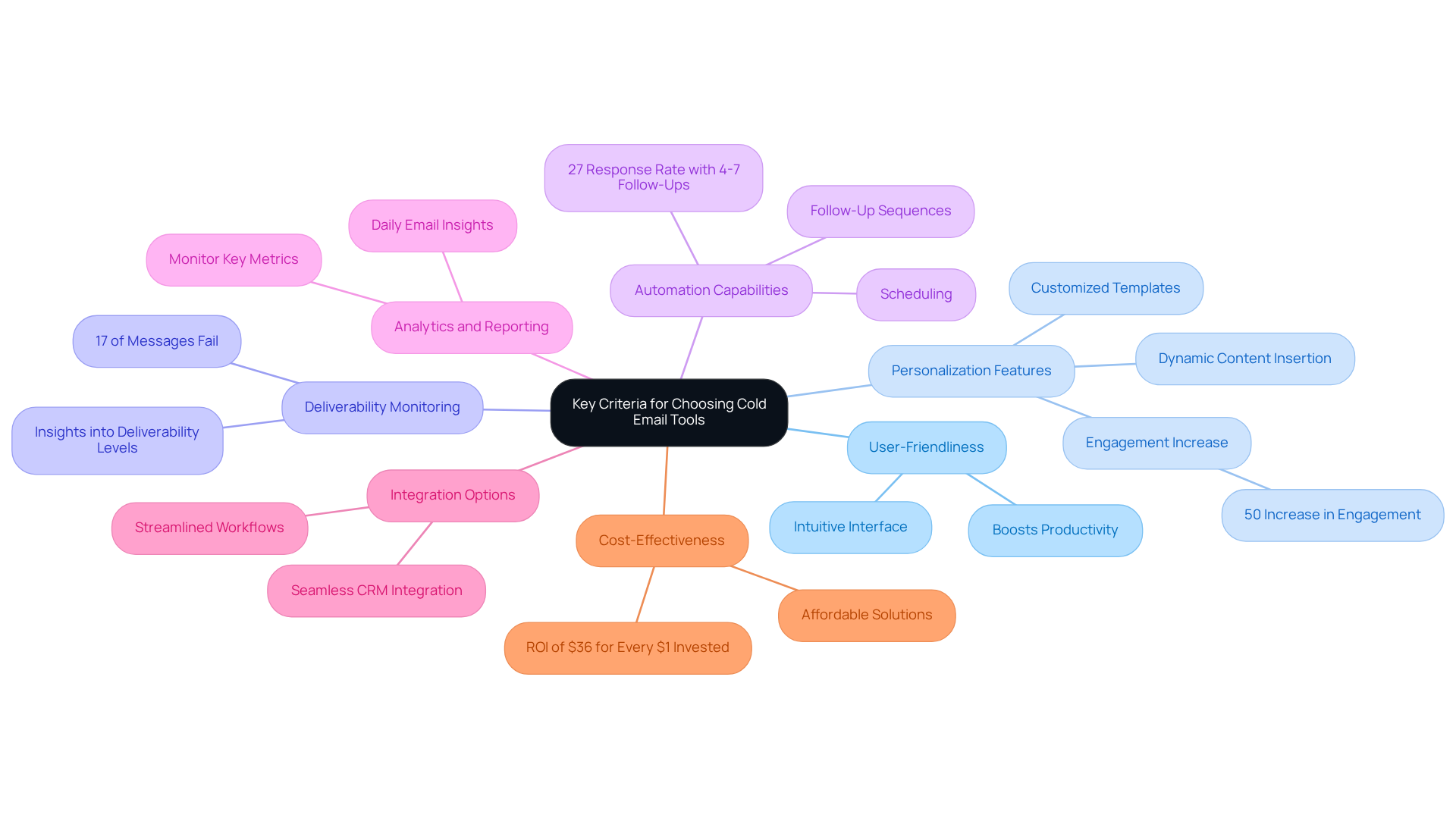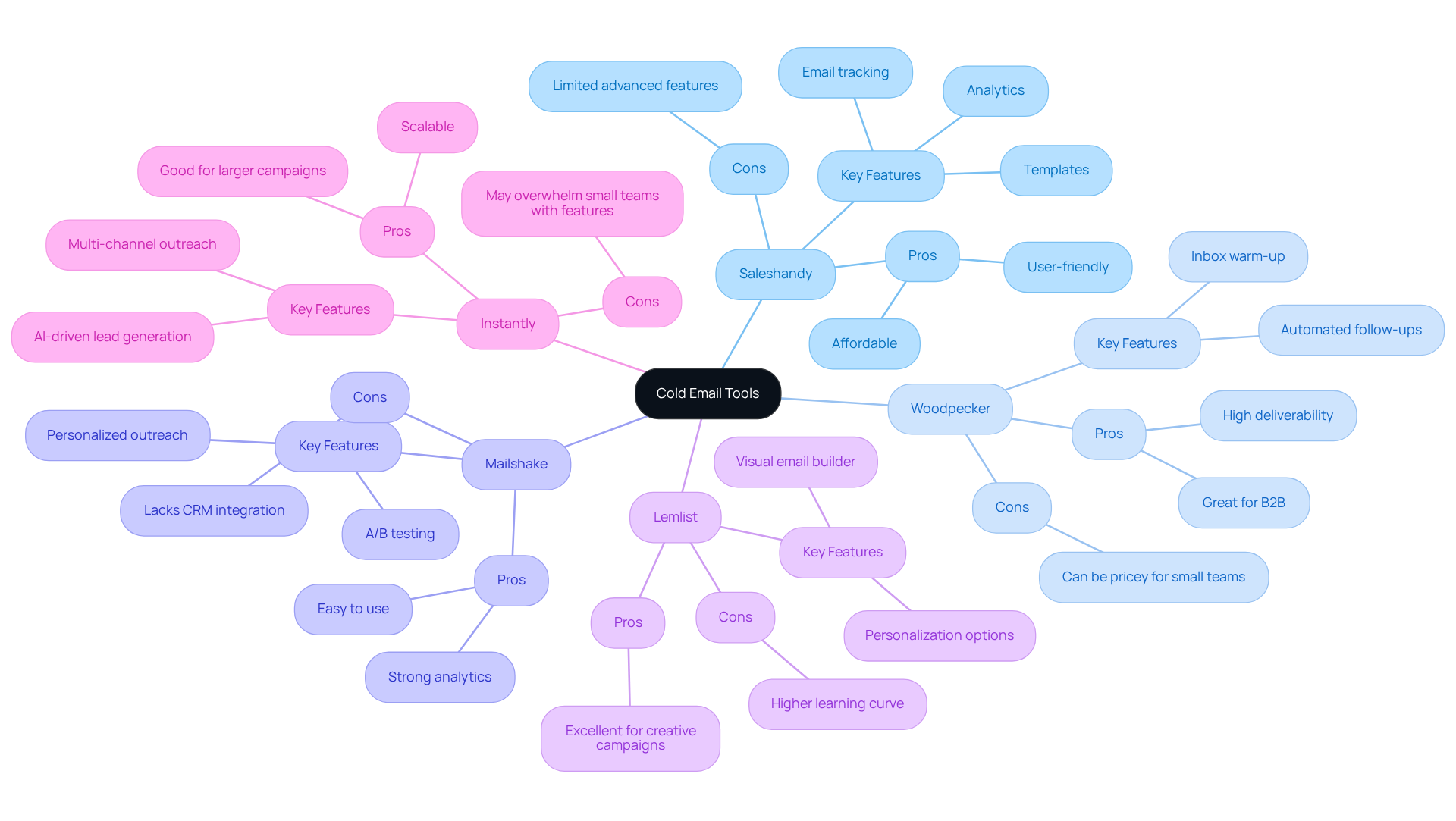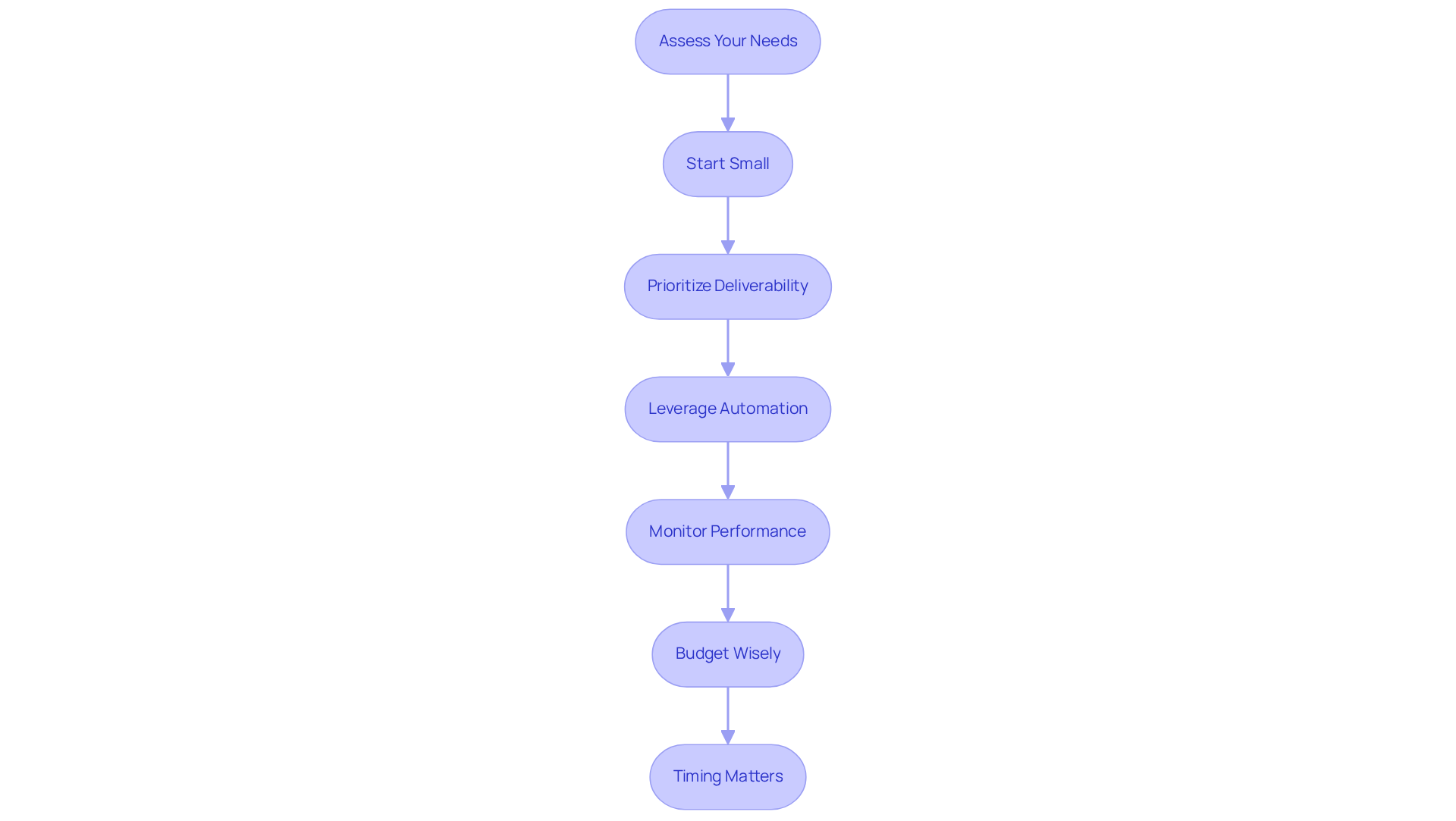Overview
This article delves into the comparative analysis of cold email tools tailored for small businesses, highlighting their vital role in generating leads and nurturing client relationships. We understand the challenges you face, and selecting the right tools can feel overwhelming. To ease this process, we outline essential criteria for choosing effective tools, such as:
- User-friendliness
- Personalization features
- Automation capabilities
Additionally, we provide insights into the strengths and weaknesses of various popular cold email platforms, empowering you to make informed decisions that align with your business needs. Together, we can navigate the landscape of cold email tools and find the solutions that best support your growth.
Introduction
In today's competitive landscape, cold emailing has become an essential strategy for small businesses eager to connect with potential clients. We understand your challenges, and by leveraging tailored outreach, you can build meaningful relationships without the burden of hefty marketing costs.
Yet, we recognize that the journey can feel overwhelming when it comes to selecting the right tools. What features truly make a cold email tool effective, and how can you navigate your options to maximize your lead generation efforts?
This article offers a comparative analysis of the best cold email tools available, providing insights designed to empower you as a small business owner. Together, we can optimize your outreach strategies and help you thrive.
Understanding Cold Emailing for Small Businesses
Cold email tools provide a thoughtful outreach technique that allows organizations to connect with potential clients who may not yet be familiar with their offerings. For small enterprises, employing cold email tools is a cost-effective way to generate leads and foster meaningful connections. Unlike traditional marketing methods, cold emailing promotes personalized communication, enabling businesses to tailor their messages to specific audiences. This customization is crucial; research shows that:
- Personalized subject lines can increase open rates by 50%.
- Tailored messages yield a 17% average response rate, compared to just 7% for generic messages.
- Emails that include the recipient's name enjoy an impressive response rate of 43.41%.
This strategy not only helps in building brand awareness but also encourages direct engagement with potential clients, making cold email tools an invaluable resource for small business owners looking to expand their reach without a hefty financial burden. When executed effectively, cold emailing can lead to higher response rates, especially when messages are crafted with care and strategy. In fact, campaigns that consist of 4-7 messages in a sequence achieve a reply rate of 27%, which is three times higher than those with only 1-3 messages. However, it's important to recognize that only 8.5% of cold messages receive a response, highlighting the challenges that come with this approach. By leveraging these insights, small enterprises can enhance their outreach efforts and significantly improve their lead generation outcomes. Together, we can navigate these challenges and achieve greater success.

Key Criteria for Choosing Cold Email Tools
When selecting cold email tools, we recognize that small business owners encounter unique challenges. Prioritizing several essential criteria can help maximize your outreach efforts and foster meaningful connections with potential clients.
-
User-Friendliness: An intuitive interface is crucial. Imagine navigating a tool effortlessly, without the need for extensive training. This ease of use can significantly boost your productivity, allowing you to focus on crafting impactful messages rather than grappling with complicated software.
-
Personalization Features: Tools that offer customized templates and dynamic content insertion can dramatically enhance engagement. Did you know that personalized messages can increase engagement levels by as much as 50%? Utilizing these features is vital for connecting meaningfully with your audience.
-
Deliverability Monitoring: It's essential to choose tools that provide insights into deliverability levels, helping you understand how many messages reach their intended recipients. This insight is critical since approximately 17% of cold messages fail to arrive in inboxes due to inadequate domain authentication or spam filters.
-
Automation Capabilities: Automation features, such as follow-up sequences and scheduling, can save you valuable time and improve outreach efficiency. Studies indicate that campaigns with 4-7 follow-up messages achieve a response rate of 27%. This highlights the importance of automated follow-ups in sustaining engagement.
-
Analytics and Reporting: Comprehensive analytics allow you to monitor key metrics like open rates, click-through rates, and conversion rates. Tools like Wayy.ai provide daily email insights that track leads and conversion rates, which are crucial for refining your strategies and enhancing overall campaign performance. Features like the one-click sales playbook and targeted outreach further boost the efficiency of these resources.
-
Integration Options: The ability to integrate with your current CRM systems or other marketing tools can streamline your workflows and enhance productivity. Seamless integration ensures that data flows smoothly between platforms, reducing manual entry and potential errors.
-
Cost-Effectiveness: We know that small enterprises often operate on tight budgets. Finding resources that offer robust features at an affordable cost is essential. An economical solution can yield substantial ROI, with cold outreach campaigns generating an average of $36 for every $1 invested when executed properly.
By focusing on these criteria, small business owners can choose cold email tools that enhance outreach initiatives and nurture meaningful relationships with potential clients. Together, we can achieve success in your outreach efforts.

Comparative Analysis of Top Cold Email Tools
Tool Name | Key Features | Pros | Cons | |------------------|--------------------------------------------------|----------------------------------------------|----------------------------------------------| | Saleshandy | Email tracking, templates, analytics | Affordable, user-friendly | Limited advanced features | | Woodpecker | Automated follow-ups, inbox warm-up | High deliverability, great for B2B | Can be pricey for small teams | | Mailshake | A/B testing, personalized outreach | Strong analytics, easy to use | Lacks CRM integration | | Lemlist | Visual email builder, personalization options | Excellent for creative campaigns | Higher learning curve | | Instantly | AI-driven lead generation, multi-channel outreach | Scalable, good for larger campaigns | May overwhelm small teams with features |
As you explore these tools, consider how each one aligns with your outreach goals and operational needs. For instance, Saleshandy stands out for its affordability and user-friendly design, making it a popular choice among small business owners. Have you thought about how a tool like this could streamline your email outreach efforts? On the other hand, Woodpecker offers automated follow-ups and impressive deliverability rates, which can be particularly advantageous for B2B communications. However, keep in mind that its pricing might be a factor for smaller teams.
By understanding the strengths and weaknesses of these resources, you can make informed decisions that enhance your cold email tools for effective campaigns. Together, we can navigate these choices to find the best solutions for your business needs.

Recommendations for Small Business Owners
For small business owners looking to enhance their cold emailing efforts, we understand that choosing the right tools can be overwhelming. Here are some caring recommendations to help streamline your selection process:
-
Assess Your Needs: Take a moment to evaluate the scale of your outreach and identify the specific features that will best serve your business objectives. Understanding your needs is crucial, especially when considering that 70% of initial cold emails do not receive follow-up efforts. This highlights the importance of efficient resources. Moreover, following up strategically every three days can lead to a 40% higher response rate compared to following up only once every seven days.
-
Start Small: If you’re new to cold emailing, we suggest beginning with user-friendly platforms like Saleshandy or Mailshake. These tools can help you become familiar with the process without adding unnecessary complexity to your efforts.
-
Prioritize Deliverability: Choose tools that offer robust deliverability tracking. With the average bounce rate for cold emails at 7.5%, ensuring your emails reach potential clients is vital for your success.
-
Leverage Automation: Consider utilizing automation features to streamline your outreach efforts. This allows you to focus on other critical aspects of your business while maintaining consistent communication with your prospects.
-
Monitor Performance: Regularly review the analytics provided by your chosen tool. With cold emails achieving an average response level of 8.5%, using performance data to refine your strategies can significantly boost engagement levels. Think about A/B testing subject lines to further optimize your open rates.
-
Budget Wisely: Keep an eye on your costs and select tools that provide the best value for your investment. Remember, cold outreach campaigns can generate an ROI of up to 4400%. Making informed financial decisions is essential, especially for small enterprises operating on limited budgets.
-
Timing Matters: Be mindful of when you send your messages. Research indicates that sending unsolicited messages on Tuesdays can greatly enhance the chances of opens and replies, particularly between 10 AM and 11 AM in the recipient's local time zone.
By following these thoughtful recommendations, small business owners can confidently navigate the landscape of cold email tools, optimizing their outreach strategies for improved results. Together, we can achieve success in your cold emailing endeavors.

Conclusion
Cold emailing offers a remarkable opportunity for small businesses to connect with potential clients and nurture relationships that can lead to growth. By utilizing the right cold email tools, organizations can enhance their outreach efforts, benefiting from personalized communication and strategic follow-ups. This approach not only increases engagement but also builds brand awareness in a cost-effective manner.
In this article, we highlight essential criteria for selecting cold email tools. Consider factors such as:
- User-friendliness
- Personalization features
- Deliverability monitoring
- Automation capabilities
- Cost-effectiveness
Each of these aspects plays a crucial role in maximizing outreach efforts, ensuring that messages reach their intended recipients and resonate with them. Our comparative analysis of top tools provides insights into their strengths and weaknesses, empowering small business owners to make informed decisions tailored to their specific needs.
Ultimately, we encourage small business owners to assess their unique requirements, prioritize deliverability, and leverage automation to streamline their cold emailing strategies. By following these recommendations, you can navigate the competitive landscape of outreach and significantly improve your lead generation outcomes. Embracing these insights will empower your business to harness the full potential of cold emailing, transforming prospects into loyal clients and driving long-term success together.
Frequently Asked Questions
What is cold emailing and how can it benefit small businesses?
Cold emailing is a thoughtful outreach technique that allows small businesses to connect with potential clients who may not yet be familiar with their offerings. It is a cost-effective way to generate leads and foster meaningful connections.
How does cold emailing differ from traditional marketing methods?
Unlike traditional marketing methods, cold emailing promotes personalized communication, enabling businesses to tailor their messages to specific audiences, which enhances engagement and effectiveness.
What impact do personalized subject lines have on cold email effectiveness?
Personalized subject lines can increase open rates by 50%, making them a crucial element of effective cold emailing.
What is the average response rate for tailored messages compared to generic messages?
Tailored messages yield a 17% average response rate, while generic messages only achieve a 7% response rate.
How does including the recipient's name in an email affect response rates?
Emails that include the recipient's name enjoy an impressive response rate of 43.41%.
What is the recommended number of messages in a cold email campaign for higher response rates?
Campaigns that consist of 4-7 messages in a sequence achieve a reply rate of 27%, which is three times higher than campaigns with only 1-3 messages.
What is the overall challenge associated with cold emailing?
Only 8.5% of cold messages receive a response, highlighting the challenges that come with this outreach approach.
How can small businesses improve their lead generation through cold emailing?
By leveraging insights on personalization and message sequencing, small enterprises can enhance their outreach efforts and significantly improve their lead generation outcomes.




